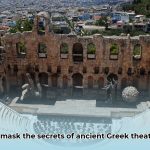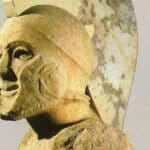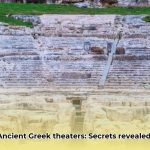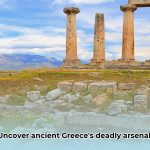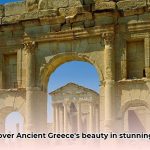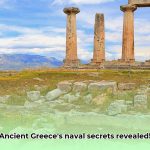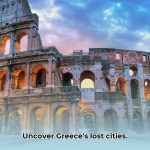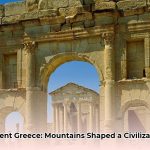Ever wondered where our love of drama comes from? Let’s journey to ancient Greece, where theatre wasn’t just entertainment – it was a vital part of life, a way to celebrate gods, explore profound ideas, and even satirize politicians! We’ll trace the incredible evolution of Greek theatre, from its origins in religious festivals to the timeless plays of Sophocles and Aristophanes. Discover the key figures, the ingenious technology they employed (imagine stagecraft without electricity!), and how their narratives and techniques continue to inspire artists and audiences today. Prepare for a captivating exploration of masks, choruses, and epic tales that forever transformed the world of theatre. Learn more about the amazing engineering behind these theaters by visiting this article.
Ancient Greek Theatre History: A Journey Through Time
Let’s journey through time to explore the world of ancient Greek theatre! It’s a narrative brimming with gods, goddesses, drama, and wit – one that continues to influence how we tell stories on stage. Reflecting on its origins, ancient Greek theatre has profoundly impacted modern storytelling.
From Rituals to Remarkable Plays: Understanding Dramatic Innovation
Our adventure commences around the 6th century BC. Envision vibrant religious festivals honoring Dionysus, the god of wine, theatre, and fertility. These were not somber religious observances; think lively celebrations with music, dance, and passionate choral chants. These spirited events laid the groundwork for what we recognize today as theatre. Scholars still debate the precise details of this shift from ritual to fully-fledged drama, but it’s a fascinating puzzle! In these energetic celebrations, the seeds of theatrical performances began to sprout.
The transition was gradual. Early performances may have involved a single actor interacting with a chorus – a contrast to the complex plots of later works. Yet, these initial steps steadily evolved into elaborate narratives, marking a critical point in theatre history: the birth of dramatic innovation.
The Titans of Tragedy: Aeschylus, Sophocles, and Euripides
By the 5th century BC, tragedy had exploded onto the scene as a distinct genre. This is where the drama truly intensifies! Three legendary playwrights – Aeschylus, Sophocles, and Euripides – completely reshaped what theatre could achieve. Aeschylus, credited with introducing a second actor, revolutionized storytelling. This seemingly small change had a huge impact, allowing for dialogues and intricate storylines. Aeschylus’ pioneering work created opportunities for future playwrights.
Sophocles, known for complex plots and deep character studies, further refined the art. He sharpened the narrative focus. Then came Euripides, who challenged audience expectations with his unconventional characters and stories, questioning traditional beliefs and tackling moral issues. Sophocles’ exploration of complex characters pushed the boundaries of storytelling. These three luminaries laid the foundations of tragedy – each building upon the other’s innovations. They were the superstars of their era!
Aristophanes: The Master of Laughter and Old Comedy
While tragedy explored profound themes of destiny and suffering, comedy provided a vital contrast. Aristophanes, the undisputed master of Old Comedy, used his plays to satirize politicians and society. Imagine him as an ancient world version of a sharp-tongued comedian – but with more biting satire! Old Comedy was known for its outrageousness and direct attacks, offering insight into Athenian life. Compared to the gentler New Comedy (which came later), Old Comedy reveals the turbulent political and social climate of ancient Athens. Aristophanes excelled in using humor to critique aspects of Athenian society.
The Theatre Itself: Innovation in Design and Technology of Ancient Greece
Ancient Greek theatre was not solely about the plays; the venues were marvels of engineering and design. Picture vast open-air theatres carved into hillsides, capable of accommodating thousands of spectators. The orchestra, the circular performance area, was the central focus. The theatron, the seating area, offered incredible views. It must have been incredible to witness – a communal experience! These open-air theatres provided an immersive experience for audiences.
Masks were a defining feature, enabling actors to portray multiple roles and convey emotions to large audiences. Elaborate costumes enhanced the spectacle. The “three-actor rule,” limiting speaking roles to three actors, fostered creativity. Playwrights had to be resourceful with props and costumes. The limitation encouraged innovation! The use of masks and costumes heightened the theatrical spectacle.
A Legacy That Endures: The Enduring Impact and Lessons
The influence of ancient Greek theatre stretches far beyond its time. Its groundbreaking techniques and storytelling continue to inspire playwrights, directors, and actors. The plays’ themes – justice, fate, mortality, and humanity – still resonate. Ancient Greek theatre has left an enduring artistic influence on contemporary theatrical productions.
Look at modern plays: you’ll see echoes of Greek structure, chorus-like elements, and architectural similarities in theatre designs. The impact of ancient Greek theatre is undeniable. It’s a heritage that continues to shape how we tell stories through the performing arts.
The Mysteries and Ongoing Debates Surrounding Ancient Greek Theatre
While we know much about ancient Greek theatre, some aspects remain mysterious. The origins of tragedy, the extent of women’s roles (both on and off stage), and the improvisation in comedic performances continue to challenge scholars. Ongoing research adds layers to our knowledge. Despite our extensive knowledge, aspects of ancient Greek theatre remain uncertain, inviting further investigation.
Here are key questions that spark debate:
| Question | What We Know | What We Don’t Know |
|---|---|---|
| Origins of Tragedy | Connected to Dionysian rituals, but the exact evolution is uncertain. | Specific aspects transitioned directly from ritual to drama? |
| Women’s Roles | Limited evidence suggests women were excluded from acting, though they were likely audience members. | True extent of their participation or influence? |
| Improvisation in Comedy | The balance between scripted material and improvisation is debated. | Freedom actors had to create scenes spontaneously? |
These questions emphasize that our understanding of ancient Greek theatre is evolving. Every new discovery adds another piece to the puzzle, painting a richer picture of this aspect of ancient Greek culture. This rich history invites exploration and discovery, ensuring that the legacy of ancient Greek theatre continues to inspire for generations.
How did the three-actor rule influence character development in ancient Greek tragedies?
Let’s return to ancient Greece, a time when theatre was a vital part of society. Imagine the scale of the performances, the power of the chorus, and a simple rule: only three actors could speak at once. How did the three-actor rule influence character development in ancient Greek tragedies? The three-actor rule played a pivotal role in shaping narratives of ancient Greek tragedies.
The Constraints that Fueled Creativity in Character Development
The three-actor rule, while restrictive, was a catalyst. It forced playwrights to master economy, suggestion, and character revelation through dialogue and stagecraft. Think of a sculptor working with limited marble – the result is more refined; a richer piece of art. By forcing ingenuity, the three-actor rule enriched character development.
Aeschylus, Sophocles, Euripides: Masters of Limitation and Character Depth
Aeschylus, credited with introducing the second actor, revolutionized storytelling. The second voice allowed for conflict, debate, and deeper exploration of inner lives. Sophocles, the maestro of tragedy, added a third actor. This expanded character interaction, allowing for nuanced relationships and complex plots. Euripides, known for psychologically complex characters, exploited dramatic elements, including the limited actors. Could their plays have been as profound without this constraint? Aeschylus, Sophocles, and Euripides demonstrated skill in maximizing depth with limited resources.
Beyond Words: Masks, Chorus, and Stagecraft in Character Portrayal
The three-actor rule wasn’t the only factor. Masks, conveyed emotions and identities. The chorus, a vital element, was both narrator and commentator, enriching the narrative and adding depth to characters’ actions. Think of stagecraft—the ekkyklema (rolling platform revealing offstage scenes), or the mechane (crane used to introduce gods)—techniques that worked around the three-actor rule. Masks, the chorus, and stagecraft techniques were crucial to compensate for limited cast size.
The Enduring Legacy of Resourceful Storytelling Techniques
The ingenuity born from limitations continues to resonate. Playwrights and filmmakers employ similar techniques—limited casts, flashbacks, dream sequences—to tell complex stories. These methods echo the innovation in classical Greek theatre. Consider how playwrights today, employ similar storytelling tactics. The impact is profound.
Key Takeaways:
- The three-actor rule pushed playwrights to develop character development techniques.
- The constraint encouraged dialogue and reliance on visual storytelling through masks, chorus, and stagecraft.
- This rule’s influence is undeniable in the works of Aeschylus, Sophocles, and Euripides.
- The rule’s legacy continues to inspire modern playwrights and filmmakers, demonstrating the power of storytelling.
Ancient Greek Theatre Architecture: Innovations in Design and Construction
Key Takeaways:
- Ancient Greek theatres blended functionality with aesthetics.
- Their design prioritized acoustics, sightlines, and audience capacity.
- The evolution of Ancient Greek Theatre Architecture: Innovations in Design and Construction societal changes and artistic advancements.
- Understanding this architectural history enriches our appreciation of Greek drama and its impact.
From Rituals to Theatres: The Birth of Dramatic Spaces
Imagine the early days of Greek theatre. Performances began as rituals, likely in open spaces. Gradually, dedicated spaces emerged. These structures were simple, perhaps a cleared area with a raised platform. It’s an evolution from spontaneous gatherings to design. The evolution from open spaces to dedicated theatres reflects advancements in Ancient Greek Theatre Architecture: Innovations in Design and Construction.
The first theatres were carved into hillsides, a natural amphitheater form. This provided seating, audience capacity. Were they practical choices, or something more? The integration of nature into performance – a symbol! Hillside amphitheatres created a connection between nature and theatrical performance.
The Orchestra and the Chorus: Shaping the Space of the Theater
The orchestra (circular dancing space), was central to the performance. The chorus, moved and sang within it. This dictated the theatre’s shape. Circular or semicircular orchestras influenced audience seating. The design of the orchestra was fundamental to the chorus’ performance.
The positioning of the chorus shaped the design. Their movements defined the space. This interplay between performance and architecture is fascinating.
The Skene: Stagecraft and Architecture Intertwined
The skene (backdrop), evolved. It started as a hut-like structure, providing a place for actors to change costumes or enter/exit. Over time, it served as a decorative background and stage setting through painted scenes. The skene played a role in setting the scene and providing a backdrop.
The skene’s development impacted the architectural possibilities. It allowed for complexity in staging and storytelling. The rise of stage machinery required adaptation. Did the theatrical needs dictate the size and features of the skene?
Acoustics: A Masterpiece of Sound Engineering in Ancient Greek Theatres
The acoustics of ancient Greek theatres are a source of wonder. The hillside seating, combined with the shape of the orchestra, created sound projection. Whispers were audible from the furthest seats. While the methods remain speculation, they harnessed natural acoustics. Acoustics played a role during construction.
How did they achieve perfection without modern technology? This continues to intrigue engineers. The mystery adds to the legacy of Ancient Greek Theatre Architecture: Innovations in Design and Construction.
The Theatre of Epidaurus: A Landmark of Design
The Theatre of Epidaurus stands as a pinnacle of ancient Greek theatre architecture. Its acoustics, capacity (around 14,000 spectators), and integration into its landscape still draw awe. The theatre of Epidaurus is a great example of architectural innovation.
It exemplifies the blend of functionality and aesthetics. This theatre is a testament to their architectural prowess.
Lasting Influence: From Antiquity to Modern Stages
The legacy of Ancient Greek Theatre Architecture: Innovations in Design and Construction is undeniable. Modern theatre design echoes principles of sightlines, acoustics, and audience engagement. Its influence remains throughout the world.
While modern theatres utilize technology unavailable to the ancient Greeks, the principles of creating an immersive performance space persist. The enduring excellence of Greek theatre architecture continues to shape the design of contemporary performance spaces.
Social and Political Contexts of Ancient Greek Theatre Productions
Key Takeaways:
- Ancient Greek theatre was woven into Athenian society, reflecting and shaping its values.
- Religious festivals, especially the Dionysia, provided the ground from which theatre sprouted.
- Plays served as tools for social commentary, exploring issues of justice, morality, and the human condition.
- The political climate influenced the content and reception of theatrical works, sometimes leading to censorship or controversy.
- Greek theatre’s structure—the chorus, masks, open-air venues—mirrored the social and political organization of ancient Greece.
From Ritual to Refined Art: The Birth of Greek Theatre
Imagine a bustling Athenian marketplace, the air thick with anticipation. It’s time for the City Dionysia, the dramatic festival of the year. The roots of Greek theatre lie in these religious celebrations, honoring Dionysus (god of wine, fertility, and theatre). Early theatrical performances evolved into structured dramatic presentations. This transition reflects a shift in Social and Political Contexts of Ancient Greek Theatre Productions, moving from religious expression to a blend of religious observance, civic participation, and innovation. These festivals served as a catalyst to dramatic productions.
Was this evolution smooth, or were there obstacles to overcome? That’s a question that fascinates scholars.
Tragedy: Exploring Fate and Human Frailty in Society
Tragedy, with its focus on the downfall of noble figures, wasn’t just drama; it served as a mirror to Athenian society. Playwrights like Aeschylus, Sophocles, and Euripides used these narratives to explore questions about justice, fate, and the human condition. Their works, performed in open-air theatres, became platforms for examining social issues, critiquing political power structures. The themes within tragedies reflected societal values.
Did audiences always interpret these messages in ways the playwrights intended? Historical records offer partial answers.
Comedy: Mocking Power and Social Norms with Humor
In contrast to tragedy, comedy, particularly the works of Aristophanes, offered satire and social commentary. These plays poked fun at politicians, philosophers, and social conventions, sometimes courting controversy. Aristophanes’ plays, were they risk alienating segments of the Athenian audience? Analyzing their reception requires careful consideration of the existing Social and Political Contexts of Ancient Greek Theatre Productions. Their wit held a mirror to Athenian society, challenging norms and provoking laughter and discomfort. Comedies delivered social commentary and poked fun at political leaders.
The Chorus and the Polis: A Shared Experience Connecting Society
The chorus, a group of performers who commented on the action and interacted with the characters, is a key element reflecting societal dynamics. The chorus often represented the voice of the Athenian citizenry, acting as a bridge between the performers and the audience. They heightened the communal aspect of the theatrical experience, underscoring the shared identity of the polis (city-state). The chorus provided a cohesive element that bound the audience and performers together.
How did the chorus’s role evolve to reflect the changing social and political landscape? What aspects of Athenian civic life does the chorus embody?
Masks, Staging, and Social Hierarchy Within Theater Productions
The use of masks, served both practical and symbolic purposes, was another feature reflecting the social structure. Masks helped amplify actors’ voices for audiences in large open-air theatres, but they also served to make characters identifiable. The size of the masks, combined with costumes, emphasized visual impact. The architecture of the theatres, illustrates the importance and civic participation in theatrical events. The use of masks combined with costumes emphasized visual impact. These elements reveal much about the Social and Political Contexts of Ancient Greek Theatre Productions.
A Lasting Legacy: From Ancient Greece to the Modern Stage
Greek theatre’s influence is undeniable. Its conventions—the structure of plays, the use of the chorus, tragic and comedic elements—have reverberated through Western drama for millennia. Their themes continue to resonate, proving the power of storytelling. From Shakespeare to modern playwrights, traces of Greek drama can be found. Studying Greek theatre is exploring history but also engaging with questions about humanity.
- Discover Ancient Greece Weapons: A Comprehensive Guide to Military Technology - August 8, 2025
- Discover Ancient Greek Swords: A Comprehensive Guide - August 8, 2025
- Explore Ancient Athens: Unveiling the City’s Secrets Through Maps - August 8, 2025

